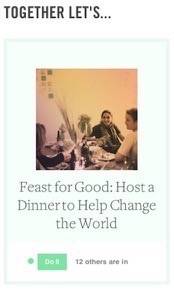
GOOD used to be a magazine. It attracted doers and makers and activists, people with a civic mission. It wasn’t able to make a lasting business out of that, and in June, it laid off most of its editorial staff. It relaunches Wednesday, and it’s almost unrecognizable. Instead of staff voices, the voices on the new GOOD are those of the doers, makers and activists themselves.
There are still GOOD staff behind the scenes. In fact, GOOD founder Ben Goldhirsh says “we’re going to create more original content in the next year than we did in the past year.” But instead of dictating what’s good to the audience, which is already active and engaged in its own projects, GOOD now works for its members.
“We are moving GOOD from a media company to a global community of pragmatic idealists,” Goldhirsh says. GOOD’s problem was that its audience didn’t need to be told what was good by editorial experts. The readers were the experts.
GOOD learned its lesson at the events it hosted. “People weren’t coming to engage with the staff of GOOD,” Goldhirsh says. “They were coming to engage with the people who share the values of GOOD.” So the new site is a place for them to hang out and collaborate. The staff are there to support and amplify the audience’s efforts.

The site has been designed as a forum. It has three sections. The section called For You displays links from people you follow on the site. These can lead to articles, and members can vote on whether they’re good, or to tasks called Dos, which call the activists on the site to action.
The GOOD staff takes the pulse of its community and bumps up worthy material to the For All Of Us section. It’s organized into topical sections, currently education, design, business and living. Much of this is sourced from the community, but original GOOD material also shows up here.
And since GOOD is ultimately about spurring its members to action, the third section is a sidebar called Together Let’s… It displays tasks or events that need community support. Events featured in this sidebar are displayed prominently, so it gives worthy causes a better chance to succeed.

It’s an intriguing model for a media company with a focused and passionate audience. It does away with the editorial guesswork of trying to educate these already smart people and lets them generate the ideas instead. Goldhirsh made an interesting comparison: As LinkedIn is to the professional self and Pinterest is to the aesthetic self, GOOD.is aspires to be for the civic self.
Your GOOD profile is a collection of the things that seem good in your world. And since the whole site is designed around your ideas, you can change it just by contributing. To pragmatic idealists like those GOOD wants to attract, society itself should work that way.

















